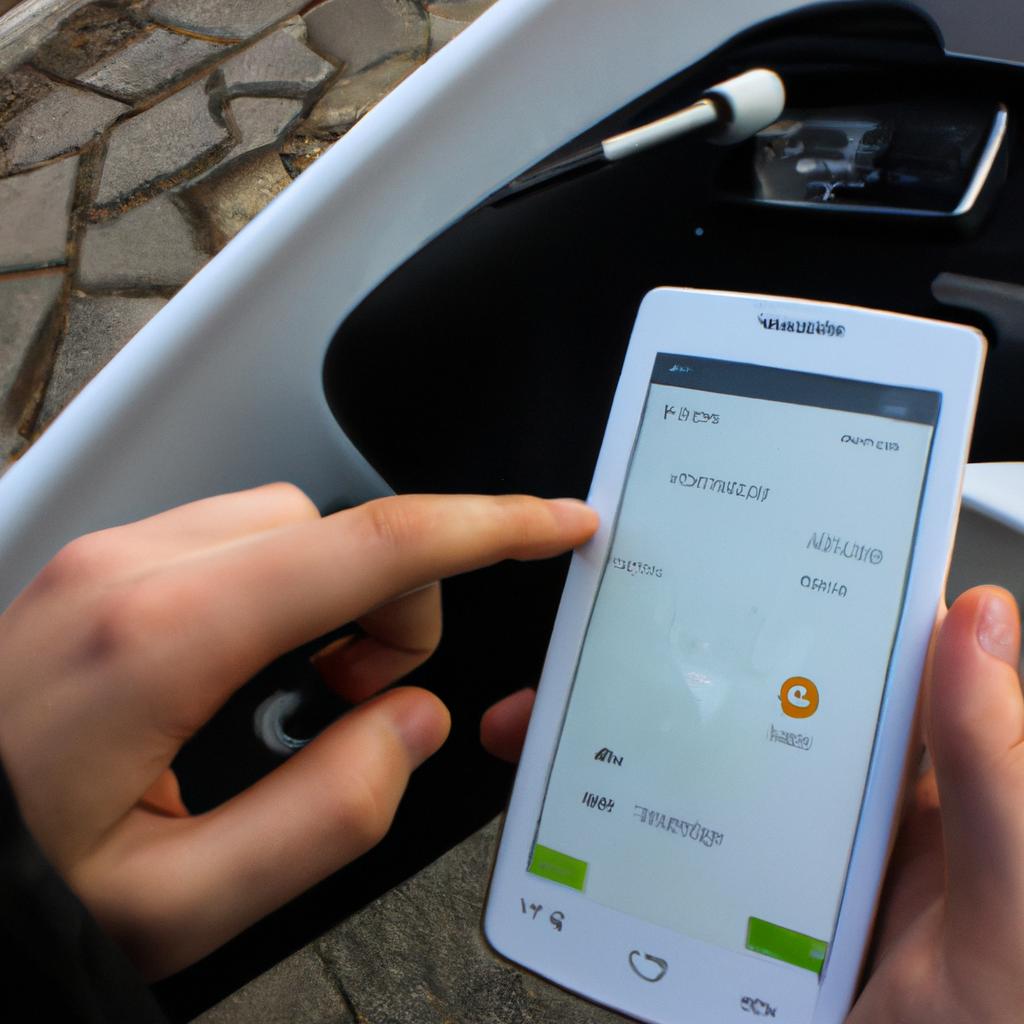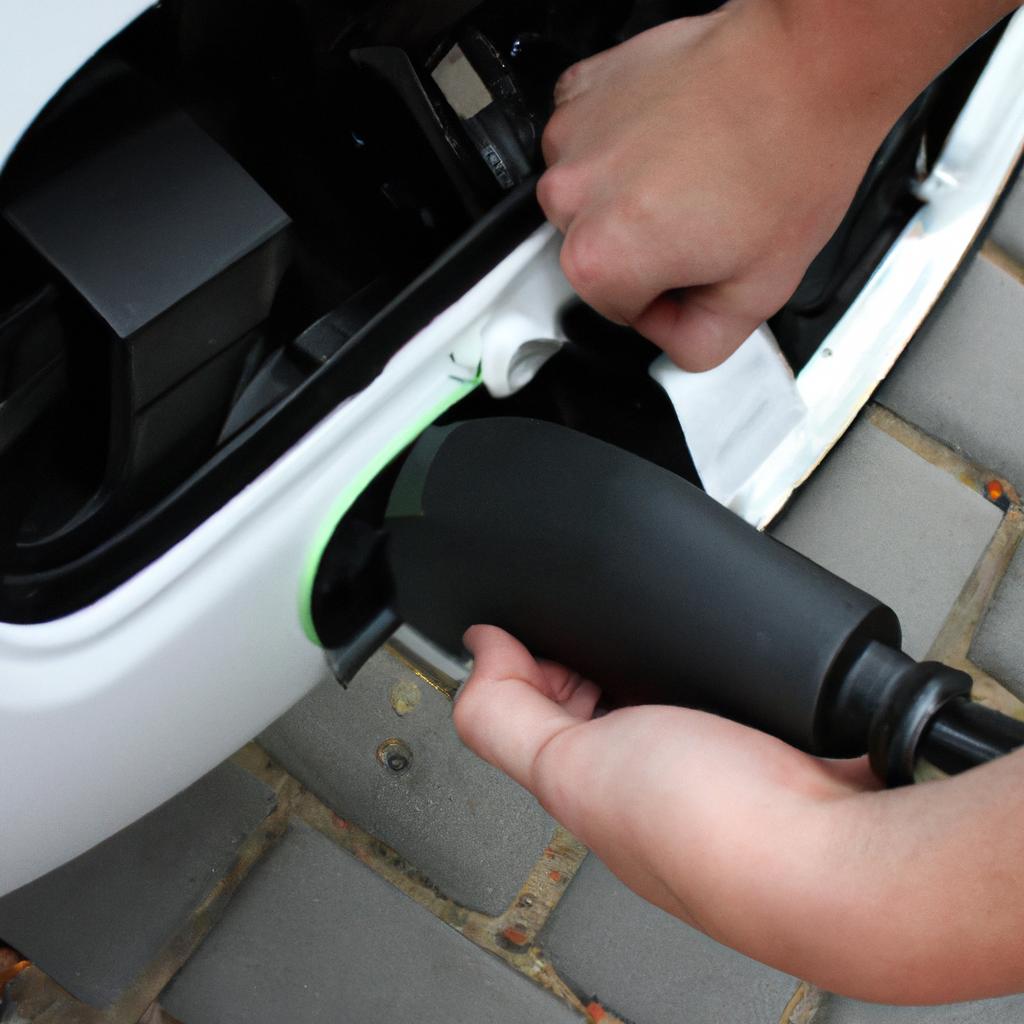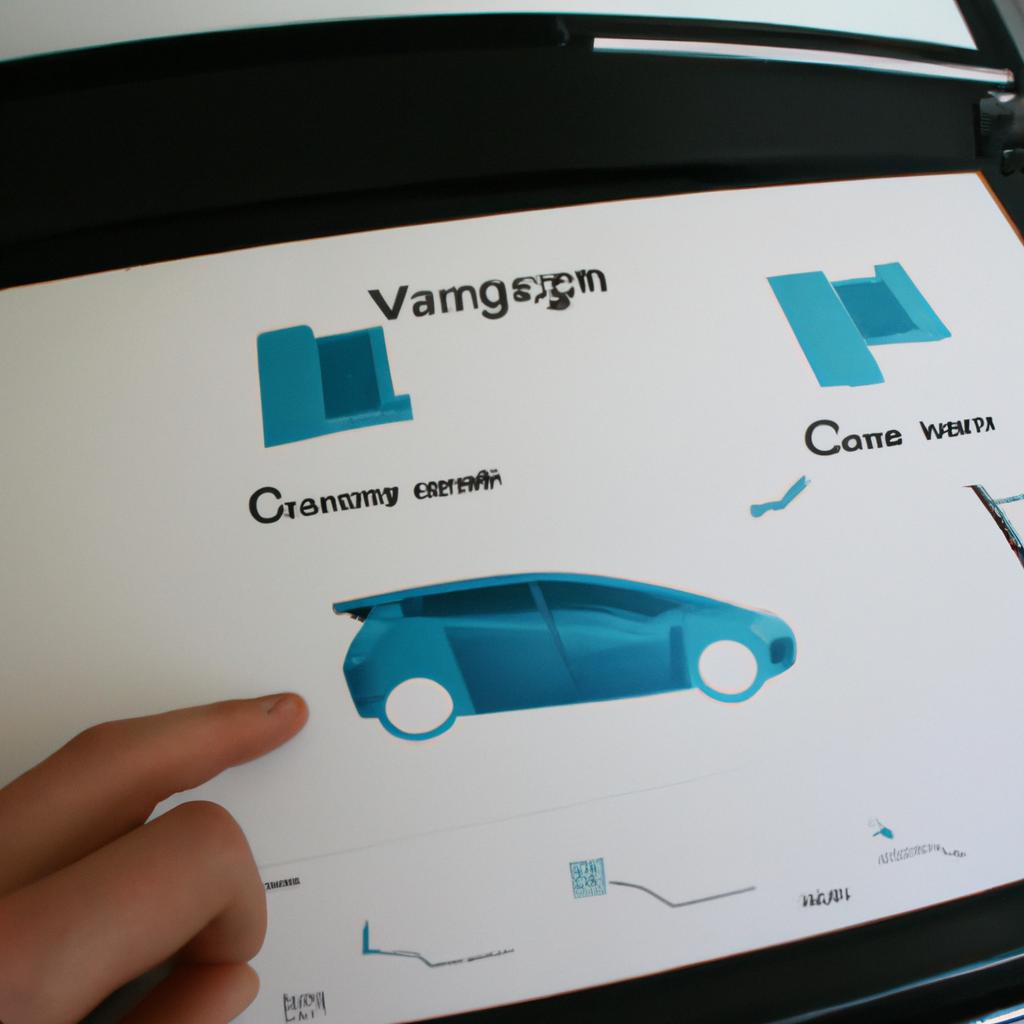In recent years, electric vehicles (EVs) have gained significant attention as a promising solution for reducing carbon emissions and mitigating the impact of climate change. However, one persistent concern that often deters potential EV drivers is range anxiety – the fear of running out of battery charge before reaching their destination. This article aims to delve into driving habits and strategies that can help overcome range anxiety with EVs.
Consider this hypothetical scenario: Sarah, an environmentally-conscious individual residing in a bustling urban area, has recently purchased her first electric vehicle. Excited about contributing to a greener future, she embarks on a road trip across the country. As she ventures further away from major cities, Sarah becomes increasingly aware of her limited access to charging stations in remote areas. Faced with uncertainty about whether she will be able to reach her planned destinations without experiencing dreaded range anxiety, Sarah starts seeking solutions that can alleviate her concerns.
Range anxiety remains one of the primary barriers preventing wider adoption of electric vehicles among consumers. By understanding driving habits and implementing effective strategies, individuals like Sarah can confidently embrace the transition towards sustainable transportation while overcoming range anxiety challenges with their electric vehicles.
Understanding Battery Capacity
Imagine you are planning a road trip with your electric vehicle (EV) from New York City to Miami, a distance of about 1,100 miles. As an EV owner, you may be concerned about range anxiety – the fear of running out of battery power before reaching your destination. To overcome this common concern and make informed decisions during your journey, it is crucial to understand battery capacity and its implications for driving habits.
Exploring Battery Capacity:
Battery capacity refers to the amount of energy that can be stored in an electric vehicle’s battery pack. It is typically measured in kilowatt-hours (kWh), representing the total energy available for use by the vehicle. Understanding battery capacity is essential because it directly influences how far you can travel on a single charge.
To illustrate this concept further, let us consider two hypothetical scenarios: Scenario A involves owning an EV with a smaller battery pack offering a maximum range of 200 miles per charge, while Scenario B features an EV with a larger battery pack providing a maximum range of 400 miles per charge. In both cases, assuming similar driving conditions and habits, Scenario B would allow for double the distance covered compared to Scenario A without needing to recharge.
Evaluating Driving Habits:
Your driving habits play a significant role in determining the effective range you will experience with your EV. Here are four factors that impact overall battery consumption and should be considered when assessing driving habits:
- Speed: Higher speeds increase aerodynamic drag and tire resistance, resulting in more energy consumption.
- Acceleration: Rapid acceleration requires additional power output from the battery pack.
- Regenerative Braking: Utilizing regenerative braking allows recovering some energy when decelerating or coming to a stop.
- Climate Control Usage: The usage of heating or cooling systems affects overall energy consumption within the vehicle cabin.
A table below summarizes these factors along with their respective effects on battery efficiency:
| Factor | Effect on Battery Efficiency |
|---|---|
| Speed | Increases energy consumption |
| Acceleration | Requires additional power |
| Regenerative Braking | Recovers some energy |
| Climate Control | Affects overall consumption |
By understanding battery capacity and evaluating driving habits, you can effectively manage your EV’s range anxiety. The next section will delve into optimizing energy usage by employing smart charging strategies and leveraging available infrastructure. Let us explore these techniques to ensure a stress-free journey with your electric vehicle.
Optimizing Energy Usage
In order to effectively overcome range anxiety with electric vehicles (EVs), it is crucial to have a solid understanding of battery capacity and its impact on driving habits. Let’s consider an example where Sarah, an EV owner, experiences range anxiety during her daily commute.
Sarah drives a mid-sized electric sedan with a maximum range of 200 miles on a full charge. Her daily round-trip commute is approximately 50 miles. Initially, Sarah believed that she would easily be able to complete her commute without any issues. However, after a few days of driving, she realized that the actual range varied depending on various factors such as temperature, road conditions, and driving style.
To optimize her energy usage and minimize range anxiety, Sarah implemented several strategies:
-
Preconditioning: Before starting her journey, Sarah uses the car’s climate control system while still connected to the charger. This ensures that the cabin is at a comfortable temperature when she begins driving, reducing the need for excessive heating or cooling during the trip.
-
Eco-driving techniques: Sarah adopts eco-driving techniques like gradual acceleration and deceleration, maintaining a consistent speed whenever possible, and avoiding unnecessary idling. These practices help conserve battery power and extend her overall range.
-
Route planning: By utilizing navigation systems specifically designed for EVs, Sarah can identify charging stations along her route in case she needs additional power during longer trips. This gives her peace of mind knowing that there are backup options available if needed.
-
Utilizing regenerative braking: Many EVs come equipped with regenerative braking systems that convert kinetic energy into electrical energy during deceleration or braking. Taking advantage of this feature allows Sarah to recover some lost energy and increase overall efficiency.
The following table showcases how these strategies can contribute to enhancing battery performance:
| Strategies | Benefits |
|---|---|
| Preconditioning | Reduces reliance on battery for climate control |
| Eco-driving | Maximizes range by conserving energy |
| Route planning | Provides access to charging infrastructure |
| Regenerative braking | Recovers energy during deceleration/braking |
By understanding battery capacity and implementing these strategies, EV owners like Sarah can effectively manage range anxiety and make the most of their electric vehicles. In the subsequent section about “Charging Infrastructure,” we will explore how an accessible charging network plays a crucial role in further alleviating concerns related to range limitations.
Charging Infrastructure
Optimizing Energy Usage: A Key to Extending Battery Life
To address range anxiety, electric vehicle (EV) drivers must prioritize optimizing energy usage. By adopting efficient driving habits and utilizing onboard features, EV owners can maximize the distance covered on a single charge. For instance, let’s consider the case of Alex, an environmentally conscious individual who recently purchased an electric SUV for their daily commute.
- Smooth Acceleration and Deceleration: Maintaining a steady speed and minimizing sudden acceleration or braking conserves energy. This practice not only reduces wear on brake pads but also enhances battery life.
- Regenerative Braking: Taking advantage of regenerative braking allows EVs to recover some kinetic energy during deceleration. The captured energy is then converted into electricity, which recharges the battery to provide additional power for future use.
- Eco-Mode Activation: Engaging the eco-mode feature adjusts several parameters in an EV to optimize energy consumption. It may limit torque output or reduce air conditioning power while still ensuring comfortable driving conditions.
- Route Planning and Navigation Systems: Utilizing advanced route planning applications that incorporate charging station locations helps drivers make informed decisions about when and where to recharge their vehicles along the way.
To emphasize the significance of optimizing energy usage further, consider the following table:
| Driving Habit | Impact on Energy Efficiency |
|---|---|
| Smooth acceleration | Reduces overall power consumption by up to 10% |
| Regenerative braking | Increases range between charges by up to 15% |
| Eco-mode activation | Enhances efficiency by up to 20% |
| Route planning/navigation systems | Decreases chances of running out of charge |
By incorporating these practices into their everyday driving routine, individuals like Alex can alleviate concerns related to range anxiety and enhance their overall experience as EV users.
Moving forward, the focus will shift to exploring the significance of charging infrastructure in facilitating long-distance travel with electric vehicles. Planning longer trips becomes more feasible when a reliable network of charging stations is readily accessible for EV drivers.
Planning Longer Trips
Transition from the previous section:
Having explored the importance of a well-developed charging infrastructure for electric vehicles, we now turn our attention to another crucial aspect when it comes to driving habits and EV ownership – planning longer trips. Let us consider how drivers can effectively overcome range anxiety and confidently embark on journeys that extend beyond their typical daily commutes.
Section 2: Planning Longer Trips
To illustrate the challenges faced by EV owners when it comes to embarking on extended journeys, let’s take an example of a family planning a road trip across multiple states. This hypothetical scenario provides insight into the various considerations they need to address before setting off:
-
Route selection: The family must carefully plan their route, taking into account the availability of charging stations along the way. They would need to identify reliable charging points strategically placed at convenient intervals or near interesting attractions where they may want to stop.
-
Charging time optimization: During a long journey, optimizing charging times becomes critical. Drivers must be mindful of not spending excessive time waiting for their vehicle to charge while also ensuring sufficient power levels for reaching each destination. Utilizing fast-charging stations whenever possible helps decrease overall travel time without compromising convenience.
-
Alternative transportation options: In certain cases, there might be areas with limited charging infrastructure or no compatible fast chargers available. Exploring alternative transportation options such as car rentals or public transport in those regions could offer an efficient workaround until more comprehensive charging networks are established.
-
Real-time data access: Accessing real-time information regarding charger availability, compatibility, and even potential wait times enables travelers to make informed decisions during their journey. Utilizing smartphone applications or dedicated websites that provide up-to-date data regarding chargers along their chosen route empowers drivers with valuable knowledge.
Consider the following table showcasing various factors impacting long-distance EV trips:
| Factors | Impact |
|---|---|
| Charging network coverage | Determines the feasibility of long trips |
| Charger availability and accessibility | Influences charging convenience during travel |
| Vehicle range and efficiency | Dictates how far one can drive between charges |
| Charging speed and technology | Affects overall trip duration and planning |
By considering these factors, EV owners can make informed decisions when planning longer trips, minimizing the impact of range anxiety.
In our next section on “Overcoming Range Limitations,” we will explore strategies that drivers can employ to further alleviate concerns related to electric vehicle range. By implementing these approaches, individuals can confidently embrace the benefits of sustainable transportation without compromising their travel experiences or facing unnecessary anxieties.
Overcoming Range Limitations
With proper planning and overcoming range limitations, driving longer distances with electric vehicles can be a manageable experience. However, it is essential to address the issue of range anxiety that many potential EV owners may have. By understanding strategies to overcome this concern, individuals can confidently embark on longer trips without worrying about running out of battery power.
One way to alleviate range anxiety is by utilizing charging infrastructure strategically. For instance, let’s consider the case of Sarah, who plans to drive from her home in Boston to visit family in New York City – a distance of approximately 215 miles. Before starting her journey, Sarah researches available charging stations along her route and identifies three locations where she can conveniently recharge her electric vehicle. This proactive approach ensures that she will have access to necessary charging facilities at regular intervals during her trip.
To further minimize range anxiety, there are several effective strategies that EV drivers can employ:
- Utilize public charging networks: Many major highways now offer dedicated fast-charging stations specifically designed for electric vehicles. These chargers provide a significant boost to an EV’s battery capacity within a short amount of time.
- Plan routes around charging stops: By mapping out routes that include stops at well-placed charging stations or destinations with accessible charging options, drivers can break up their journeys effectively while replenishing their vehicle’s energy reserves.
- Take advantage of regenerative braking technology: Electric vehicles often come equipped with regenerative braking systems that convert kinetic energy into electrical energy while decelerating or coasting. This feature helps extend the overall range by capturing and storing energy that would otherwise be lost during traditional braking methods.
- Leverage smartphone applications: Various smartphone apps exist today that provide real-time updates on nearby charging stations’ availability and compatibility with different EV models. These apps enable users like Sarah to plan their trips more efficiently by ensuring they always have access to compatible charging points when needed.
By employing these strategies, drivers can overcome range anxiety and confidently venture on longer trips with their electric vehicles. With the increasing availability of charging infrastructure and advancements in EV technology, the feasibility of driving extended distances with an electric car continues to improve.
Understanding how to manage range anxiety is just one aspect of embracing electric vehicles. In the subsequent section, we will explore the numerous benefits that come along with owning and operating an electric vehicle while contributing to a more sustainable future.
Benefits of Electric Vehicles
Building upon the strategies to overcome range limitations, let us now explore the numerous benefits that electric vehicles (EVs) offer.
Section H2: Benefits of Electric Vehicles
Electric vehicles have gained significant attention in recent years due to their potential for reducing greenhouse gas emissions and dependence on fossil fuels. To illustrate this, consider a case study where an individual named Sarah made the switch from a conventional gasoline car to an electric vehicle. Prior to owning an EV, Sarah frequently experienced range anxiety—the fear of running out of battery power during her daily commute. However, with her new electric vehicle equipped with advanced battery technology and improved charging infrastructure, she discovered several noteworthy advantages.
Firstly, one prominent benefit is the substantial reduction in carbon dioxide emissions compared to traditional internal combustion engine vehicles. According to studies conducted by reputable environmental organizations such as the Union of Concerned Scientists, EVs produce significantly fewer emissions over their lifetime than gasoline-powered cars. This not only contributes positively towards combating climate change but also improves air quality and reduces health risks associated with pollution.
Furthermore, another advantage lies in cost savings through reduced fuel expenses. In Sarah’s case study, she observed a notable decrease in her monthly transportation budget since switching to an EV. Electricity prices tend to be more stable and predictable compared to fluctuating gasoline prices. Moreover, maintenance costs for EVs are generally lower as they have fewer moving parts and do not require oil changes or complex engine repairs.
To highlight these benefits further:
- Reduced environmental impact
- Lower long-term operating costs
- Enhanced energy efficiency
- Improved driving experience
| Benefit | Description | Example |
|---|---|---|
| Reduced environmental impact | Significantly lowers carbon dioxide emissions | 30% reduction in CO2 emissions compared to gasoline cars |
| Lower long-term operating costs | Savings on fuel expenses and decreased maintenance requirements | Average annual savings of $1,000 compared to gasoline cars |
| Enhanced energy efficiency | More efficient use of electricity for propulsion | Achieves an average of 3.5 miles per kilowatt-hour (kWh) |
| Improved driving experience | Smooth and quiet operation with instant torque delivery | Accelerates from 0 to 60 mph in under 6 seconds |
In conclusion, electric vehicles offer a multitude of benefits that extend beyond overcoming range anxiety. These advantages include reduced emissions, cost savings, improved energy efficiency, and enhanced driving experiences. As the automotive industry continues to innovate and invest in EV technology, these benefits will become even more significant, making electric vehicles an increasingly attractive option for environmentally conscious and financially savvy consumers alike.
 Sfeva
Sfeva



